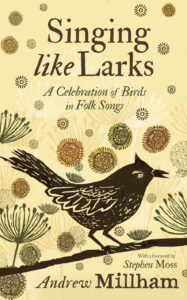Recently published by Saraband, Andrew Millham’s ‘Singing Like Larks’ opens a rare window onto the ancient song traditions of the British Isles, uncovering the remarkable relationship between birds and traditional folk music. Karen Lloyd reviews.

When another nature title lands on the mat, it’s sorely tempting to groan inwardly, or worse, to find oneself banging one’s head against the nearest doorframe. The British simply cannot get enough of what has commonly come to be called ‘nature writing’ but is all too often another outing for yet another narrative about human recovery. Authentic nature writing on the other hand, provides a combination of the unexpected together with immersive writing about place and species which helps the rest of us not only to fill in gaps in our knowledge, but to share vicariously in the experiences at hand.
Andrew Millham’s Singing Like Larks (Saraband, 2023), is an optimistic, glass-half-full kind of a book; one that allows us to share in Millham’s enthusiasm for nature itself and also with the singing traditions that once anchored us in place and time — or rather, in timelessness. Traditional, or folk songs, were and are irretrievably bound up with the cornucopia of species that were once part and parcel of our rural landscapes. This, of course, was in the days before agricultural payment systems incentivized farmers to forget the nature that had for millennia been inextricably bound up within their landscapes and their lives.
Singing Like Larks recalls songs that many of us will yet recognise from our childhood, or from our children’s childhood, such as the well-known and enigmatic ‘Who Killed Cock Robin.’ Millham’s research reveals the origins of this and many other less well-known songs where time warps backwards into a past when ritual and ancient systems of belief systems were far more closely attuned to the yearly cycle. The weft of those songs is woven throughout the book, including some of the most influential characters in the genre, such as the Copper family from Rottingdean, West Sussex, and Bob Copper in particular, whom Millham describes as ‘an out-and-out countryman with…a healthy disrespect for authority.’ In such communities, Millham writes, ‘Village life was hard but uncomplicated’; these were places where ‘settlements were like islands, intruded upon only by pedlars and itinerant workers’; places that ‘were unashamedly themselves.’ In those island communities it was not unusual for song lyrics to be pasted to cowshed walls to be learned by rote.
And then of course, these are also landscapes in which birds now of almost mythical status, such as the turtle dove, were once taken for granted. Millham pays valuable attention to the decline of this and many other species; something which is being increasingly recognised as a the great cultural shrinkage of our age. Without actual turtle doves, there can be no poetry, or songs written, or nature writing for that matter, about turtle doves; this really matters. Biological loss — of course — represents the loss of all our cultural experiences. Indeed — and who would wish to inhabit such a world? Yet the blame is not ours alone, as Millham attests. ‘A fierce ballad could be written about the deadly challenges the turtle doves face as they run the gauntlet to and from Europe during their spring and autumn migration. As they fly in a straight line…they are shot out of the skies. Malta, Italy, France and many other European countries have allowed millions of this species to be massacred for fun. If it were to stop, the…population would begin to bounce back almost immediately.’
Singing Like Larks also navigates more recent phenomena, such as Ralph Vaughan Williams cycling through the British countryside and calling at pubs to ask if anyone could sing him a song. More recently still, the Watersons — east coast folk royalty made up of Norma, Mike, Lal and cousin John Harrison, later joined by Martin Carthy and later still by Eliza Carthy who, collectively, brought the tradition into the contemporary age where the music is not just alive, but definitely kicking.
Whilst it’s tempting to describe Millham’s observational writing as lyrical, the whole he creates is actually far more than this. Handling so many interwoven threads — birds, birds in song, habitats, habitat loss, restoration, people, place and personal experience — in this accomplished way is a rare thing indeed. In a young emerging writer — one who is also a singer of the songs that are his subject — his technique manifests as a kind of effortless sleight of hand.
*
‘Singing Like Larks’ is out now and available here, published by Saraband.
Karen Lloyd is the editor of ‘North Country: An Anthology of Landscape and Nature’ (Saraband, 2022) and author of the James Cropper Wainwright Prize longlisted ‘Abundance: Nature in Recovery’ (Bloomsbury, 2021). She is the writer in residence with Lancaster University’s Future Places Centre.